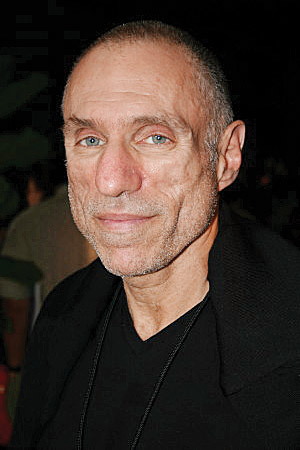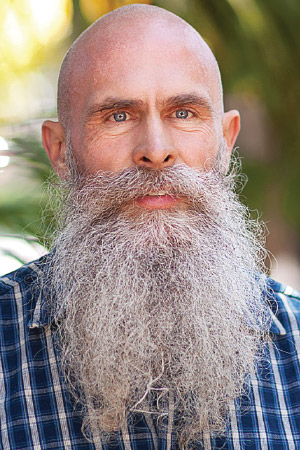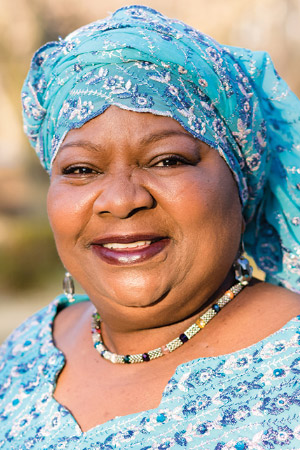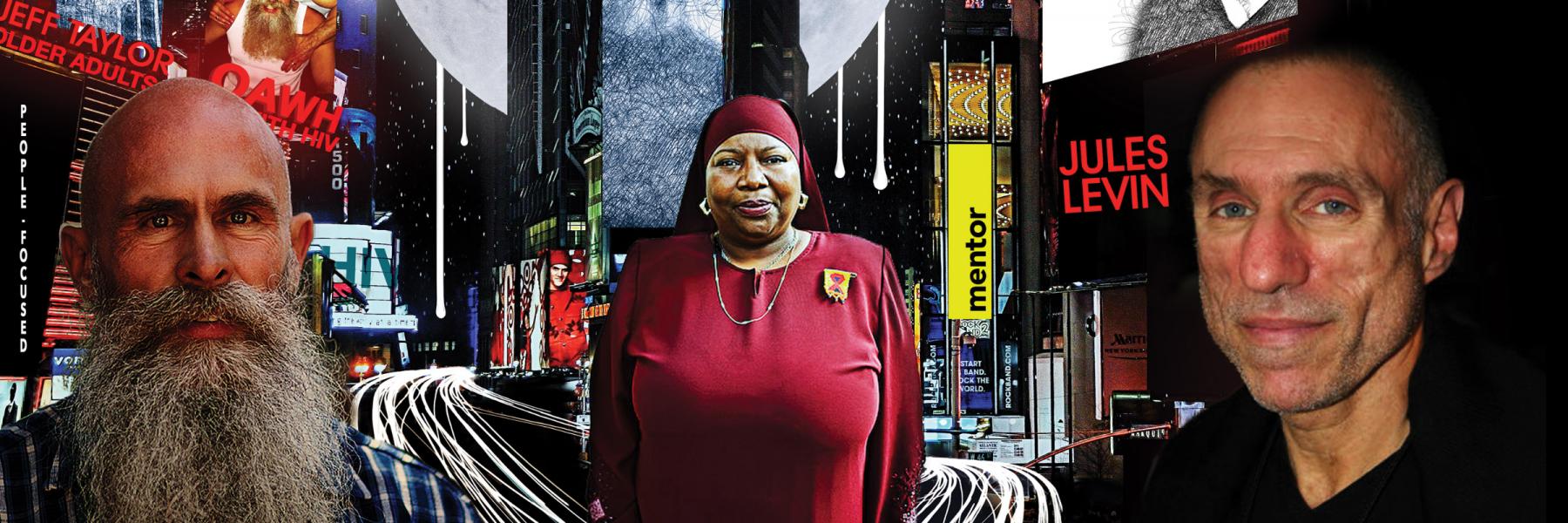There are serious challenges ahead for people aging with HIV who have a potentially high number of comorbidities, and heightened risks of serious complications and disabilities—but our health care and social services systems are not prepared to respond to the more complex needs of people living with HIV (PLWH) as we age. Our goal is to explore how to build resiliency in ourselves, in our health care, and in our community.
One way to build resiliency is through community building, mobilization, and activism, so we sought input on what should be done from three activists working in this space: Jules Levin of the National AIDS Treatment Advocacy Project (NATAP), Jeff Taylor of the HIV & Aging Research Project-Palm Springs (HARP-PS), and Waheedah Shabazz-El, the Organizing Director of Positive Women’s Network-USA.
Each of these activists are contributing in their own way to raise the profile of the unmet needs of OAWH. Nevertheless, as Jules says, the larger community of people living with HIV need to hold our community-based and advocacy organizations accountable. They need to engage in activism for OAWH in a much more substantive and effective way. In “Addressing the needs of older adults living with HIV,” Stephen Karpiak makes some recommendations for HIV-service organizations to provide more relevant and useful services, and to represent our agenda to the national policy makers.

‘It’s the number one problem that’s getting no attention. Everybody’s talking about cure and PrEP, and they’re all-important—but no one’s paying attention to aging.
Jules Levin
National AIDS Treatment Advocacy Project (NATAP)
Jules Levin is the most tenacious AIDS activist one could ever hope to meet. We met in the early ’90s, when he was just learning about treatment—before the advent of effective antiretroviral therapy (ART). There is arguably no one more knowledgeable about HIV and treatment literature than Jules. However, he is frustrated by what he sees as the lack of engagement on the part of the community and research establishment to respond to the needs of older adults living with HIV (OAWH). The following is a compilation of a number of statements Jules has made publicly and in online discussions about HIV and aging.
“It’s the number one problem that’s getting no attention. Everybody’s talking about ‘cure’ and ‘PrEP,’ and they’re all-important—but no one’s paying attention to aging.
“I’ve been working on the aging problem for more than 15 years. Well, it’s 15 years later now and so everyone’s older, and a lot of older people with HIV don’t even realize what’s going on. Every comorbidity is worse in people aging with HIV.”
- We have more comorbidities (three to eight on average) compared to HIV-negative people the same age.
- We have fifty percent more heart disease (cardiovascular disease, myocardial infarctions, and stroke rates are much greater among people living with HIV).
- We have higher rates of death from stroke.
- We have a much greater prevalence of kidney disease.
- HIV-positive people are at greater risk for fatty liver/non-alcoholic hepatic steatosis (NASH) as we have all the risk factors: diabetes, heart disease, lipid abnormalities, hypertension, metabolic abnormalities—it’s estimated NASH will one day be the greatest cause for liver transplantation.
- We have twice the rate of osteoporosis, fractures, and falls.
- Women aging with HIV face more health challenges than men.
- Depression, anxiety, and insomnia are three to seven times higher among OAWH.
- We have a greater burden of polypharmacy, more disability, more cognitive impairment, and a loss of daily independent functioning.
- A recent study from London reported that 77% of deaths among PLWH were due to comorbidities—AIDS-related conditions were the cause of death in only 15–25% of deaths.
There are only two HIV and aging/geriatric clinics in the U.S.—at Cornell and the University of California–San Francisco—but the problem extends far beyond those two clinics. Jules says we need clinics everywhere that provide special support services for OAWH and that offer better education for clinicians and expanded broader research.
Many people who are stuck in overwhelmed HIV clinics do not get the attention they deserve. One study last year found that 50% of OAWH in Washington, D.C. did not get treatment for comorbidities. In New York City, a significant number of OAWH are already homebound, depressed, and socially isolated. They do not have the wherewithal to seek out expensive treatments—which may or may not work.
Jules explains that special care and better coordination are vital to ensure that patients see the specialists they need and receive necessary treatment and services. These include better patient contact and follow-up, detailed in-depth attention, homecare, food shopping, and household maintenance. “We need to address social isolation and the fact that many are emotionally and physically impaired. With increasing disability, the need will also increase for housing and institutionalizing of those who are unable to care for themselves at home. Integral to the HIV epidemic is a population who are often living alone—having lost friends and family, unlike the HIV-negative general population, who are more likely to have family and children to assist who can care for them as they age.” As he points out, many OAWH do not have this.
Jules says that some older patients are so cognitively impaired they are unable to stay in follow-up; they don’t even recall what their specialists recommended. Moreover, their primary care provider does not have the time to address this either—which is why he says we need extended visit times, care coordination, and special support services.
Jules feels that the large community-based AIDS service organizations in major U.S. cities and Washington, D.C. policy groups have done little to influence federal or local officials to address these needs.
He points to the work being done in Europe, where the community has formed an aging coalition and meetings have been held across the continent to influence government officials. “The European AIDS Treatment Group (EATG) and many other advocates are leading this movement, but there is nothing like this in the U.S.,” says Jules.
As determined and tireless as Jules is, he can’t affect these policy changes on his own. His call to action needs an engaged community response. We asked Jules what we need to do.
“Please tell U.S. government officials and advocates that we need to better address this ‘new’ HIV epidemic.”
- We need special support services for those aging who need them in their clinics.
- We need more education for clinicians regarding prevention, care and treatment for key comorbid diseases including heart disease; brain, neurologic and cognitive impairment; and depression and social isolation—reaching out to the homebound.
- We need broader and expanded research, including more patient-focused research. NIAID [National Institute on Allergy and Infectious Diseases] priorities list aging/comorbidities in the top five, but this is a red herring. In reality NIAID and OAR [Office of AIDS Research] have made it clear to researchers that funding is severely limited in this field. Many study funding requests are denied. Requests to NIAID, the Department of Health and Human Services, and OAR to begin addressing these problems are ignored. Long-term care and living plans are not even discussed.
‘We can treat people medically, but they have a lot of psychosocial issues that are holding them back and those need to be addressed.’

Jeff Taylor
HIV & Aging Research Project, Palm Springs (HARP-PS)
“Palm Springs is a beautiful place, but it is more than just palm trees, swimming pools, and fabulous mid-century architecture. I like to call it, ‘God’s Waiting Room for Older Gay Men Aging with HIV’,” Jeff Taylor of the HIV & Aging Research Project-Palm Springs (HARP-PS), said at the HIV and Aging Conference in New York City last September. He explained how the coming together of a particularly large community of OAWH has created a unique environment for patient-focused research into HIV and aging.
According to epi-data from the Ryan White program in Riverside County, 78% of PLWH in Palm Springs and the surrounding cities are over 50 years of age; nearly 40% of those are over age 60; 10% over 70; and 1% are over the age of 80. There’s even one individual who is 92 years old. Given the high rate of migration to the valley, there are many more people who are unaccounted for in the available epi-data. Extrapolating from the HIV caseloads of the top three HIV providers in the valley, and factoring in the Veterans Administration, Kaiser, and other health systems, it is estimated that there are approximately 10,000 PLWH in the region with a similar age distribution.
The story of this community was depicted in a 2015 documentary Desert Migration, which examined the phenomenon of HIV-positive gay men moving to the desert.
“It was mostly because they had been priced out of expensive coastal California cities like San Francisco, because we have a very welcoming LGBT community, and an embarrassment of riches in terms of competent HIV providers (many are HIV-positive and aging themselves), and HIV services,” Taylor said. “As a result, Palm Springs has one of the highest prevalence of HIV-positive people over age 50 in the nation—we estimate that to be about twelve times the national average.”
Recognizing that this demographic represented an opportunity, about five years ago a group of Coachella Valley HIV providers and PLWH collaborated to create HARP-PS, a non-profit community-based initiative.
“We have received a two-year capacity building grant from the Patient-Centered Outcomes Research Institute (PCORI),” Taylor said. During those two years, the organization is tasked with bringing together all the community-based groups, care providers, and activists interested in this issue and developing the organizational structures and capacity to conduct research on an ongoing basis—and “most importantly,” said Taylor, “to identify and explore key topics for future research.”
A series of focus group meetings identified key health issues, resiliencies, and research priorities within the community.
“Cognitive function, dementia, and memory loss are a huge concern for people living with HIV,” said Taylor, though isolation and depression and financial strain were highlighted as important health issues or health considerations. “We can treat people medically, but they have a lot of psychosocial issues that are holding them back and those need to be addressed,” said Taylor.
“Secondly, and really important for us, is the concept of resiliencies. Many people are aging healthily with HIV and we want to identify what those resiliencies are, what the resources are that can help people achieve those resiliencies, and what choices people have that they can make to live healthily,” said Taylor.
Finally, Taylor said that OAWH in Coachella Valley are also living with inflammation and comorbidities and see those as research priorities. They would also like to see interventions affecting neurologic function studied.
A scientific retreat was held to come up with study ideas or concepts to evaluate—among which was the establishment of a cohort study on inflammation.
“We’re very acutely aware we have a unique population of aging people, and that one of the deficits in research is we don’t have a lot of data in people over 65, especially in their 70s, 80s, and 90s—and that can obviously serve as a platform for a lot of other research interventions.”
Among the ideas to evaluate are investigating the role of the flora and fauna in our gastrointestinal tract on cognitive function, the effect of diet and exercise on cognition, and methamphetamine interventions. They also want to evaluate the comparative effectiveness of community programs to address isolation and depression in OAWH.
California also provides a unique context to study the effects of cannabis use in the community. Another study will evaluate the use of a single dose of psilocybin (the active ingredient in “magic mushrooms”) in a controlled setting on the post-traumatic stress disorder (PSTD) that many long-term survivors are experiencing as a result of having lived through the HIV epidemic.
Currently, HARP-PS is performing a study on the effect of tesamorelin on both visceral fat and HIV-associated neurocognitive disorder (HAND), conducting a survey to measure resiliency factors in the community setting, and performing an evaluation of the effectiveness of group cognitive behavioral therapy for people with HIV-epidemic related PTSD—with the involvement of the grassroots organization Let’s Kick ASS (AIDS Survivor Syndrome).
‘We acknowledged that there’s a lot going on in local communities, but people don’t really know what’s happening elsewhere, and we thought it valuable to bring people together. We called it Creating a Framework for HIV Survival.’
Creating a Framework for HIV Survival
Another nationwide grassroots organization that Taylor is involved in is The Reunion Project (TRP). Now in its fifth year, TRP is led by a national steering committee made up of PLWH, including many who are long-term survivors. TRP conducts single-day seminars in various cities across the country to bring people together to combat isolation and build community. TPAN, the publisher of Positively Aware, serves as fiscal agent for The Reunion Project, and recently joined TRP in a three-year collaboration called Positively Aging. Positively Aging will allow TPAN to increase direct services to older persons living with HIV in Chicago, and The Reunion Project to expand its support network through its unique “town hall” programs. Information about the project and issues surrounding aging with HIV will be shared with the national Positively Aware audience.
“We get people together, acknowledge and spend a lot of time dealing with the psychosocial impact of the epidemic, addressing the trauma that people have been through,” said Taylor. “It’s also meant to be educational; there are breakout workshops where people can learn more about clinical aspects of research, such as what’s available in their community. Usually there’s a keynote speaker and a very strong social aspect with meals and events.”
The Reunion Project recently hosted a national roundtable in Rancho Mirage, California with HARP-PS, to bring together grassroots advocates from around the country who’ve been addressing this at the local level.
“We acknowledged that there’s a lot going on in local communities, but people don’t really know what’s happening elsewhere, and we thought it valuable to bring people together. We called it ‘Creating a Framework for HIV Survival,’ and created a document that’s been posted on the TPAN website (tpan.com/reunion-project),” said Taylor.
Several main themes emerged at the roundtable that advocates want to explore:
- More research into both medical and clinical care as well as socio-behavioral research.
- Programs: What kind of programming can community-based organizations offer to long-term survivors in their communities?
- Community building: How do we build community both locally as well as nationally so we can do more in this area?
- Advocacy: How do we go to the national level and make sure that we get the funding and the services we need to help people age healthily as the epidemic progresses?
Taylor and HARP-PS are also engaging with the AIDS Clinical Trials Group (ACTG) to prioritize research into aging and on the long-term effects of HIV treatment (not just in the U.S. but also globally). Taylor is pushing for the ACTG to gather more data on OAWH over the age of 65 years, and to form an ACTG Aging Working Group.
Other items on HARP’s agenda:
- To develop collaborations with other large cohorts of OAWH.
- To advocate for more behavioral and social science research to design and measure the kind of interventions that can improve the lives of people as they get older.
- To find ways to incorporate HIV into geriatric care, including training a new generation of providers in both HIV and geriatrics; and
- Collaborate to develop clinical recommendations and guidelines for the care of OAWH.
“And, of course, as we did since the beginning of the epidemic, both the research and provider communities need to partner with people living with HIV to advocate for what we need—such as research, services, and funding. We did this 30 years ago. I know we’re old and tired now, but this is a problem that’s not going to go away. If we don’t address it now, it’s just going to get worse. As ‘cranky’ and old as are, we need to ‘ACT UP’ and advocate for what we need,” Taylor concluded.
‘Geriatric-based case management is a service that may help alleviate some of the barriers to nutrition and housing for people aging with HIV.’

Waheedah Shabazz-El
Positive Women’s Network–USA
We asked Waheedah Shabazz-El, the Organizing Director of Positive Women’s Network–USA, to tell us about her background and her activist priorities to build resilience into the community of people aging with HIV.
Lance Sherriff: Can you tell us a little bit about yourself and your experience as an activist living with HIV?
Waheedah Shabazz-El: I came into the world of HIV as an older person. Diagnosed with AIDS at the age of 49, having taken my first HIV test, I was told not only did I test positive for HIV, but that I already had AIDS. My activism took off rather quickly in 2003, through amazing mentors placed in my path, including ACT UP/Philly’s John Bell, Project TEACH’s Laura McTighe, CHAMP’s JD Davids, and University of Johannesburg’s Farid Esack, to name a few.
Sherriff: What do you think are the chief challenges for people aging into their 50s, 60s, and beyond in your community?
Shabazz-El: Health care is an issue for all people who are aging. Those aging with HIV are in need of health care from providers and other specialists that have the very latest information and education around HIV. High quality geriatric care ought to be available, accessible, affordable, and non-discriminatory. Developing a “Standard of Care” for people aging with HIV—so folks do not “fall out of care.” That care ought to include transportation, because as people age generally their mobility decreases. People aging with HIV need stable, affordable, and safe housing options that are non-stigmatizing.
Sherriff: How can our community better respond to depression and isolation among older people living with HIV?
Shabazz-El: By creating opportunities for people aging with HIV—not just to gather, but to assist with the planning of an event where they can share their own stories of survival and resilience. Aging people are holding the history of the HIV/AIDS movement. We need to find ways to consult older people living with HIV and document their stories of survival. These programs ought to be held in places that offer a safe and nurturing environment. Next steps must also be guided by those who are most impacted—meaning we support people aging with HIV with transportation as well as the use of technology such as video chatting and Zoom so they can continue to engage and be engaged.
Sherriff: Surveys in several cities suggest that financial hardships, housing insecurity, and even food insecurity are leading concerns in the aging population with HIV. How do we as activists best respond to these challenges?
Shabazz-El: Surveys and listening sessions are always good ways to gauge the needs of specific communities. In the early days, as a result of stigma, many people living with HIV were forced out of their jobs, their livelihoods. An HIV diagnosis also condemned many to a life of poverty. As people age many find they have specific dietary needs—our providers are all too aware of this. Geriatric-based case management is a service that may help alleviate some of the barriers to nutrition and housing for people aging with HIV. Supplemental food vouchers, and fresh and cooked food delivery services, are very much needed. For those who own their homes, people aging with HIV need services that help to ensure we have functional heating and cooling and general maintenance. Homeowner insurance and warranty services are often extremely challenging on fixed incomes. And so, [we need] case management that understands the pressures and challenges of aging with HIV. Those who may need assisted living and identify as gay ought to have access to housing services that are not homophobic and forces people back into the closet in order to be safely housed.
Sherriff: We’ve heard about your participation in The Reunion Project (TRP). Can you tell us about your role in it and about other activists working in this space?
Shabazz-El: I am a TRP Steering Committee Member as well as a member of TRP’s Core Management Team. I was attracted to TRP because I am a long-term survivor of the AIDS epidemic. I was asked to join the Steering Committee to help develop TRP’s diversity plan of inclusivity. I was excited to bring the voices and perspectives of women and black people to TRP. The epidemic today looks strikingly different than it did 35 years ago and TRP recognized that reality. TRP’s Core Management Team meets weekly to ensure the growth and reach of TRP. We are very intentional about our grant deliverables, rolling out TRP events in the most impacted areas in the U.S. Our effort is to combat isolation and provide spaces for long-term survivors where they find a sea of calm knowing their hearts are being held by other long-term survivors—this happens through the sharing of our experiences of survival and resilience. TRP events are designed to hear from our community members.
Sherriff: Any other issues close to your heart about HIV and aging?
Shabazz-El: The lack of social safety nets for people aging with HIV is a great concern: The constant attacks on Medicare-protected classes of (one-pill, once-daily antiretroviral) drugs. The classification of HIV as a chronic condition has put psychosocial services in danger without taking into account that there is still so much stigma to deal with (unlike with other chronic conditions). Homeowner’s insurance (which would pay off a home mortgage upon the homeowner’s death) is denied due to pre-existing conditions. Barriers to life insurance due to pre-existing conditions. Finally, there is a lack of geriatric case management services that leaves people aging with HIV with challenges of access to transportation, food, safe housing, and technology as well as geriatric specialty health care.


